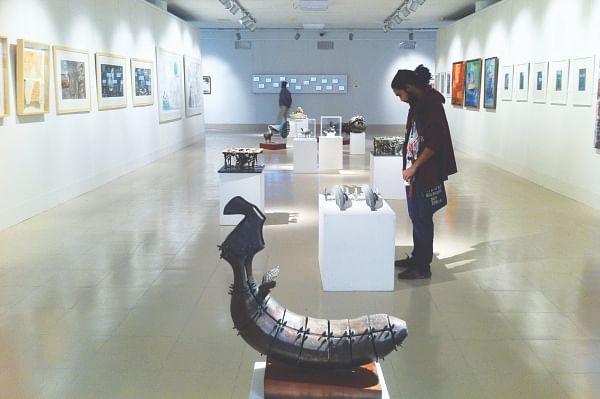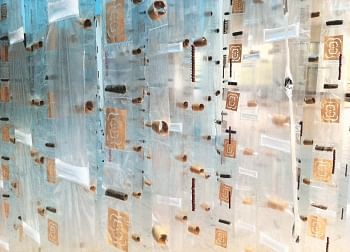| Home - Back Issues - The Team - Contact Us |
 |
| Volume 11 |Issue 49| December 14, 2012 | |
|
|
Art International Contemporaries Soraya Auer
With more than 60 active biennale art exhibitions across the globe, Asian Art Biennale Bangladesh can claim to be one of the oldest on the continent. For the first time since it was established in 1981 by Bangladesh Shilpakala Academy (BSA), the exhibition is taking place under one roof, at the National Art Gallery. This year's event showcases 138 artworks by 100 Bangladeshi artists and 237 artworks by 124 foreign artists from 33 countries, which included Pacific countries such as Australia and Eurasian countries such as Turkey and Russia. Jafar Iqbal, coordinator of 2010 and 2012's biennale, explains, “We have in previous exhibitions used three venues but for the first time we're holding the biennale in a single venue because our gallery has been recently vertically extended so there's a huge space of seven galleries.” He continues, “This event is special. One reason it is special is because it is the fifteenth edition and for thirty long years we've been having this biennale on a regular basis.” This is no small feat for Bangladesh as a handful of international biennales have stopped despite many successful editions. Japan's, for example, Tokyo Biennale was among the first of its genre in Japan and was a relatively long-standing biennale. It was the first to start in Asia in 1952 but ended in 1990 after 18 editions. While the 15th edition of Asian Art Biennale Bangladesh, an event that takes place every two years, does not face the same fate, it did struggle to take off. Subir Chowdhury, former Director of the Fine Arts Department of Shilpakala Academy, remembers how the idea came into being. “We received one packet from India regarding an International Triennale exhibition [held every three years]. We discussed that if India's Lalit Kala Academy [National Academy of Art] could organise an international exhibition, why can't we organise a solely Asian art exhibition? Then we made proposals to the government and it took four years for it to be finally approved.” He continues, “After the success of the first exhibition, we then decided we could organise this every two years as a biennale and it has been going on ever since.” Despite its respected success however, Bangladesh's biennale has not been without criticism. In an article on the event in 2008, published in the Star, Bangladeshi artists expressed their disappointment at the disorganised and impractical nature of the exhibition. Space constraint was one issue internationally acclaimed artist Monirul Islam pointed out, which the new and improved National Art Gallery takes care of. However what may interest organisers in future is how every day visitors felt about the exhibition's potential standard and quality.
“Thankfully, I'm surprised by these big exhibitions because my expectations are low,” shares Dilruba Jahan, an A-Level art student. “I've been lucky enough to see local galleries in New York and their presentation can be so impressive. Compared to this, which is supposed to be an international standard exhibition, things like no frame or a crappy label,” she points to a wonky label made of printer paper, “take away from what is otherwise a beautiful piece of art.”
“Some of the video installations weren't on so there was me staring thinking 'what am I not seeing?'” says university student Shakil Imran. “The galleries weren't clear beyond the second floor either, which is just a shame because I shouldn't have to snoop around in a dark corner to find the entrance to a section full of international pieces.” Adnan Kabir, an accountant visiting the exhibition with his art teacher wife, says, “I do like what I see, I think there are some very striking contemporary pieces here but these things have a tendency to be cluttered. Putting the participants from Maldives next to Russia's doesn't seem right. One is so colourful and evocative while the other is naturalistic and more thematic. Personally I think there needs to be a curator setting a standard throughout but that's not a common concept in Bangladesh yet.” Jafar Iqbal responds to the lack of curator by saying, “From the beginning, the system has been that we've never had a curator. We have a working 11-member committee who actually planned the biennale. The biennale has been going on but maybe in the future, the committee might have a plan to have one.” “If you have a curator, they can set a theme and choose the artists from different countries within the theme but the process we are following is that we're approaching the government to assign a commissioner who will choose the quality artworks from the country to send to us and we accept them,” says Iqbal. The coordinator, also an artist himself, however offers his personal thoughts, “Even though we have a lot of space, my personal opinion is that I think 100 Bangladeshi artists are a bit much [compared to the 42 local artists in 2010's event]. I would've fixed the number at 50 or 70, which would be great.” Chowdhury, now Director of the Bengal gallery of Fine Arts, adds on the suggestion of a curator, “For Bangladesh, we have no curator but some countries had a curator for their selection at the biennale. I think if Bangladesh engaged with two or three curators for this biennale then it would be greatly improved and we'd see more beautiful works.”
Nine awards were given in this year's biennale, which featured a total of 224 artists and 375 pieces of art. Some were more obviously deserving than others such as Palestinian Bashar Al Hroub's Grand Prize winning 'Out of Frame', which evoked an eerie feeling with his photographs of a man pressed against a white sheet, and Nepalese Rajan Kafle's 'Pandemic', which has multiple consumer products such as food containers, alcohol bottles and pieces of technology, shaped into insects with metal legs walking towards a wooden archway. Established Bangladeshi artists Kazi Salahuddin Ahmed, Zihan Karim and Yasmin Jahan Nupur also received awards for canvases as well as installations. Other artworks admired by visitors includes Gulshan Hossain's 'In Remembrance of the Tormented Women of 1971', which has 18 swings, hanging at staggered heights with girls' names painted on the black empty seats, and Mohammad Wahiduzzaman's 'Taboo Wall of Society', which could be seen from two sides, one side with sketches of naked prostitutes and women's faces joined together with hair and the other side with cut outs of playboy bunnies and umbrellas on transparent plastic which allowed the viewer to still catch a glimpse of the faces and bodies on the other side of the 'wall'. “There are a lot of new young artists participating this year, art students as well and from different parts of Bangladesh, not just from Dhaka,” claims Iqbal. “It's a real opportunity for them because this exhibition is a highly prestigious exhibition in this country. For many of the artists this event creates a scope for local artists to meet foreign curators, observers and other organisations so many of them end up sending their artwork to them,” he says, adding that some artists wait two years specifically to participate in this exhibition. Chowdhury agrees, “For Bangladeshi participants this is a good opportunity. From Dhaka they can see what is going on in Asia with contemporary art. Whatever is going on at present in the art scene of Iran or Palestine, they can see here in Dhaka, this is a great help for them. It's an international exhibition and they can expose themselves to an international platform through this exhibition.” With this motivation to guide Bangladesh Shilpakala Academy, the Asian Art Biennale Bangladesh has the potential to continue to grow and improve. The 15th Asian Art Biennale Bangladesh is taking place at the National Art Gallery at Bangladesh Shilpakala Academy in Shegunbagicha, Dhaka. It is open every day 11am to 8pm except for Fridays when it is open 3pm to 8pm. Copyright
(R) thedailystar.net 2012 |




